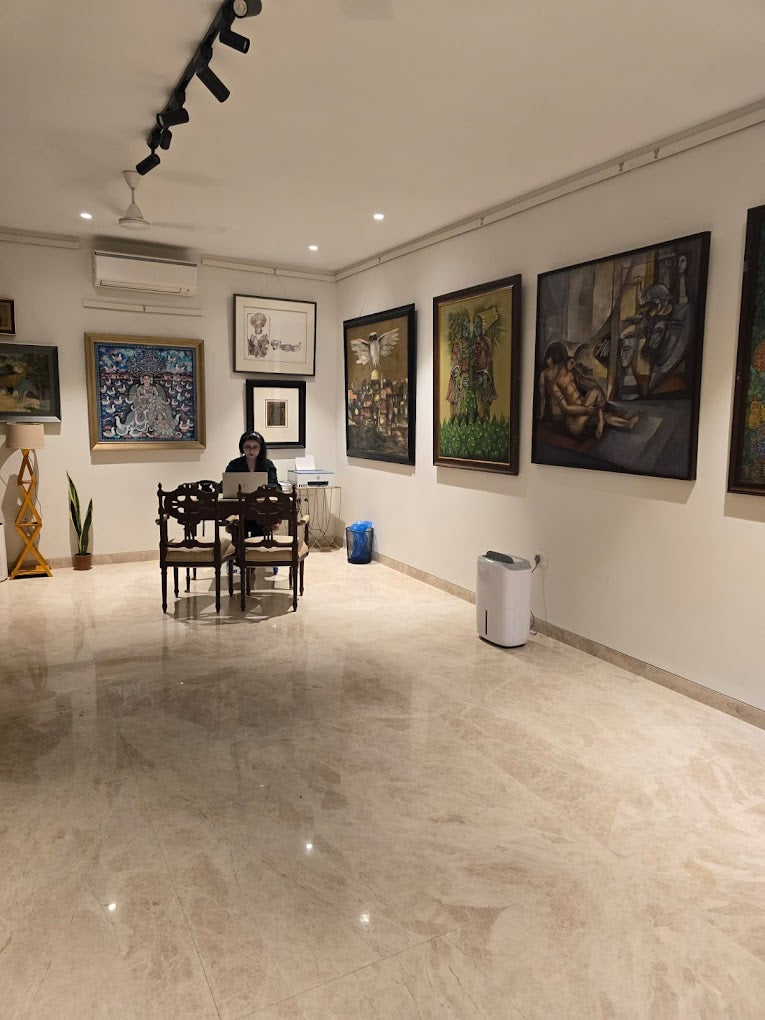Gallery Silver Scpaes
Weaver from Kalahandi
Weaver from Kalahandi
Couldn't load pickup availability
Artist: Manu Parekh
Medium: Oil on Canvas
Size: 60 × 48 inches (152.4 × 121.92 cm)
A haunting meditation on human endurance, Weaver from Kalahandi by Manu Parekh delves into the psychological and socio-political dimensions of rural India with unflinching clarity. Executed in oil on canvas, this evocative work transcends mere representation to embody a deeply symbolic narrative of struggle, resilience, and entrapment.
The central figure, a weaver from the impoverished Kalahandi district, is portrayed with a face divided into dual expressions: one side exuding quiet dignity, the other marked by profound despair. This bifurcation is more than a formal device; it underscores the emotional fragmentation born of systemic neglect. Against a tense yellow backdrop, the figure becomes a vessel for collective suffering and muted protest. Parekh’s use of color is deliberate and emotionally charged, yellow here vibrates not with warmth, but with tension, anxiety, and impending rupture.
One of the painting’s most compelling elements is the figure’s exaggerated hands, rendered with both expressive tenderness and monumental weight. These hands evoke the act of weaving, a gesture rooted in tradition and livelihood, while simultaneously suggesting entrapment, as if the same limbs that sustain life also serve as instruments of subjugation within an unyielding socio-economic system. The loom-like structure in the background reinforces this duality, functioning both as a spatial anchor and as a visual metaphor for a cage. The weaver is not merely positioned in front of it but seems almost absorbed into its grid, highlighting the inescapable cycles of poverty and marginalization.
Above, a solitary incandescent bulb hangs, an emblem of lost promise and dimmed aspiration. Its presence hints at a potential for enlightenment or progress, now suspended in the still air, never quite reaching the weaver’s world. The crisscrossing strings throughout the composition resemble snares, visually trapping the figure within a web of structural injustice while simultaneously referencing the material of his craft. Parekh’s mastery lies in his ability to fuse figuration with abstract spatial devices, turning the canvas into both a portrait and a statement. Weaver from Kalahandi is not merely a depiction; it is a lament, a protest, and ultimately a tribute to the endurance of labor in the face of silence and systemic erasure. Through layered metaphor and painterly precision, Parekh creates a powerful, resonant work that confronts the viewer with both beauty and unease.


Why Choose Us
Art has always, naturally, reflected the development and exploration of different thoughts and perceptions, and our current postmodern era is no different. It is interesting to see how art has evolved visually, yet the traditional methods of composing art remain a valid means of expression.
All it takes for an artist to rise above normalcy, is inspiration, which fuels his passion to paint beautiful creations throughout his life.
The valuable expression of art is always there with us, but now this expression is yet to take an interesting diversion with our art gallery, Gallery Silver Scapes, located in Hauz Khas Enclave. Art is no longer considered just decorative but has evolved and come forth as a major form of investment yielding high rates of returns for its buyers, making it an expression commonly used.

Mrs Mayor was walked into the art world by the legendary modernist Bimal Das Gupta, one of whose biggest collections remains with Gallery Silver Scapes. In the 1980s, as head and first curator of the Habiart Gallery founded by Mrs Rekha Modi — a childhood friend — Mrs Mayor worked closely with and curated shows for renowned artists such as A Ramachandran, GR Santosh, Rameshwar Broota, Sakti Burman, MK Bardhan, Dhiraj Chaudhury, M Sivanesan, and Arup Das among others.
Besides modern masters, she also worked with young contemporaries such as Sudip Roy, Paresh Maity, Subroto Kundu, Vinod Sharma, and many more. Artworks commissioned by her are now part of prestigious collections, such as those of the India Habitat Centre, Ranbaxy, Pepsi, Hotel Lalit, Bank of America, and many more private and public collections.


